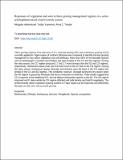Responses of vegetation and soils to three grazing management regimes in a semi‐arid highland mixed crop‐livestock system

View/
Date
2014-10-14Author
Habtemicael, Mezgebe
Yayneshet, Tesfay
Treydte, Anna C.
Metadata
Show full item recordAbstract
Three grazing regimes [Cut‐and‐carry (CC), seasonal grazing (SG) and continuous grazing (CG)] currently applied in Tigrai region of northern Ethiopia were compared to identify the best grazing management in key native vegetation and soil attributes. More than 50% of the desirable species such as Andropogon, Cynodon and Phalaris spp were located in the CC and SG regimes. During the rainy season, the CC regime produced 1.7 and 2.7 more biomass than the SG and CG regimes, respectively. Herbaceous basal cover was 6.8 times more in the CC than in the CG regime. During the rainy season, herbaceous species diversity and richness were the least in the CG regime but similar in the CC and SG regimes. This similarity, however, changed during the dry season when the SG regime is grazed by livestock that led to a reduction in diversity. These results suggest that CC is superior to the traditional CG, but not always necessarily superior to the SG. The SG regime improved soil P status while the CG regime affected soil bulk density and total N negatively. The predominantly native vegetation grazing systems in Tigrai region can be improved cost effectively through cut‐and‐carry and seasonal grazing.
